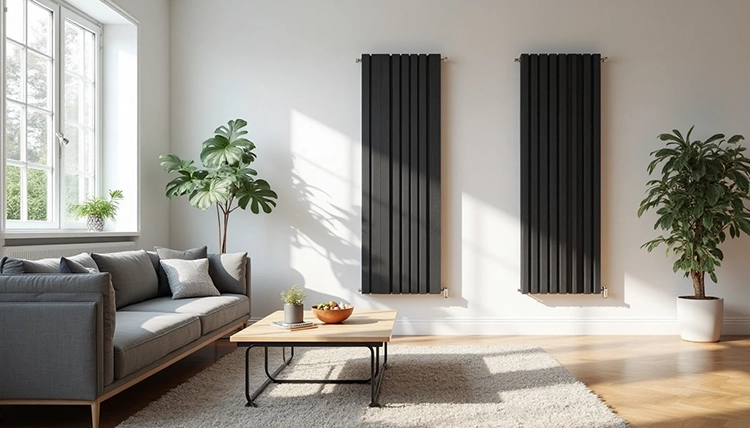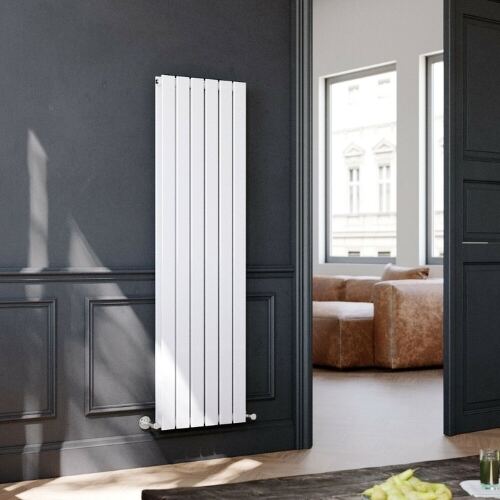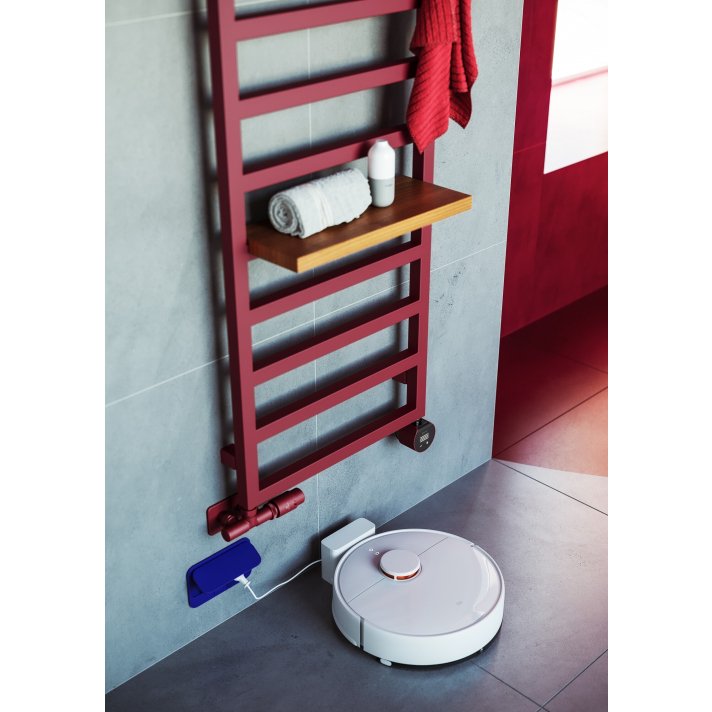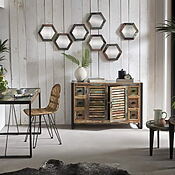Vertical radiators are becoming increasingly important in modern interior design - and for good reason. They break open horizontal lines, make rooms look larger and create more space for furniture and decorations. These space -saving design elements prove to be a refined solution, especially in rooms with a limited wall such as kitchens and baths.
The decision to purchase vertical radiators brings numerous advantages. Designer radiators are now available in hundreds of colors, allowing them to be perfectly matched to any interior design style. They not only impress with their aesthetic appearance—their efficiency can even be superior to that of their horizontal counterparts "chimney effect."
This effect ensures improved air circulation and thus more efficient spatial warming. While traditional radiator concepts often take up a lot of space, vertical models support compact living concepts space -saving radiators At the same time, they offer additional functions, such as drying towels or hanging clothes with magnetic brackets.
Vertical radiator as an architectural statement
Modern design radiators have gone through remarkable change in recent years - from a pure heating element to the architectural design element. The vertical orientation offers much more than just functional warmth; It creates an aesthetic statement that upgrades every room.

this illustration is used for illustration and was created with the help of an image AI
Visually extend the room height
Vertical radiators cleverly use the third dimension of a room. Due to their aspiring form, they break open the otherwise horizontal visual lines and direct the view up. Especially in rooms with high ceilings, they develop their full effect by emphasizing the vertical dimension and thus creating a more generous space perception.
In fact, you can visually stretch smaller rooms and give them more space. This visual effect is consciously used by interior designers in order to give rooms more dynamics and make the proportions more harmonious.
Clear vertical accents
The clear, modern design language of this radiator sets optical highlights in every room and creates a contemporary atmosphere. Design radiators have achieved a quantum leap: it became the pure useful object to the heating bed, which can be used decoratively. You can also give an apartment your own character and set conscious style accents. The variety of designs enables the right model for every furnishing style - be it a classic, rural or elegant, modern interior.
With the lavish selection of colors and surfaces, the radiator can either be harmoniously inserted into the existing furnishings or set accents with high -contrast and expressive colors. Furthermore, many models are available in different dimensions that enable individual adaptation to the room conditions.
Support a space -saving living concept
Vertical radiators save space, especially in width. They use significantly less wall surfaces than their horizontal counterparts, which means that the freely staying wall can be used as a laying or decorative area. At the same time, they are real problem solvers in rooms with limited space, such as kitchen or bathroom, as they can be installed in areas that would otherwise remain unused.
Vertical radiators in rooms with floor -to -ceiling windows are particularly advantageous. ”
While traditional radiators are usually placed horizontally in front of the windows and thus restrict views and setting opportunities, vertical models can be attached to narrow wall pieces, which would otherwise be given away space. In modern buildings with extensive window surfaces, they skilfully overcome horizontal restrictions and can also be used in narrow variants with only 300 mm width.
In addition to the lower space requirement, some vertical design radiators offer additional functions: they can be equipped with accessories such as clothing hooks or towel rods and thus transform into multifunctional pieces of furniture that optimally meet the space -saving living concept.
Color choice: integrate discreetly or bravely highlight
The color design of vertical heating bodies plays a crucial role in their integration into the room concept. While traditional radiators mostly come in neutral white, modern design radiators open up innovative design options - from subtle adaptation to the brave style of style.
Radiators in wall paint for quiet rooms
If you strive for a harmonious, calm space impression, you can deliberately let vertical radiator to be recovered optically. If radiators are painted in the same color as the wall, they dip visually and become almost invisible.
A noble effect can be achieved in particular with matt lacquer qualities, since these are similar in their surface structure of the wall color and hardly reflect on the light. As a result, the radiator fits seamlessly into the overall picture and does not distract attention from the room concept.

Image source: Bouwstation Retail BV
Accent colors as a conscious break
In contrast, you can buy a vertical radiator to use it as an eye -catcher. Those who demonstrate the courage to color can create exciting contrasts with black, turquoise or red paints. For example, black radiators have an elegant effect in front of dark wall surfaces, while turquoise models set modern accents in the living room.
For bathrooms, on the other hand, there are red tones that give the room a warm wellness atmosphere. In addition, manufacturers are increasingly experimenting with exceptional color combinations - from white and pink to noble gold tones.

Image source: Bouwstation Retail BV
Variety of colors for modern design heating bodies
The selection of available colors is impressive: design radiators are now available in 70 to 200 different colors. Well-known manufacturers refine their vertical radiators with a carefully curated range of twelve colors- including subtle gray, brown and bronze tones as well as classic black and white. In addition to different colors, there are also different surface structures for choice, from structured coatings to smooth surfaces in warm and cool color shades.
Powder -coated surfaces are particularly high quality that not only guarantee color equality, but also convince with their durability. These coatings specially developed for architectural applications are characterized by excellent mechanical properties- they are impact and liability-resistant and absolutely abrasion-resistant.
For individual design requests, some manufacturers even enable multicolored coatings or printing out motifs.
Cross -style usability in interior design
The versatility of the vertical radiators is particularly evident in their adaptability to various furnishing styles. Thanks to their large variety of designs, they are no longer limited to a certain style of living, but enrich almost every interior.
Can be combined with rustic and classic furniture
Contrary to popular belief, vertical radiators aren't just suited to modern interiors. In fact, they also harmonize with classic and rustic furniture. The extensive variety of designs and the wide range of colors and metallic finishes make it easy to find the right heat source for every interior style. Whether it's a more classic, rustic interior or an elegant, modern one, there's a suitable solution.
Suitable for open living concepts
In modern, well -insulated buildings with open living concepts, vertical radiators develop their strengths. Unlike in the past, they no longer have to be attached under the window. This opens up to previously unknown design options. In addition, vertical radiators often harmonize better with the interior than their horizontal counterparts.
For a harmonious overall picture, many manufacturers offer horizontal and vertical models in the same design, so that both variants can be perfectly combined.
Design radiators in the kitchen, bathroom and hallway

Image source: Bouwstation Retail BV
Vertical radiators prove to be a real problem solver, especially in rooms with limited space such as the kitchen or bathroom. They can be installed in areas that would otherwise remain unused. Modern buildings with large window areas often limit the space for horizontal radiators - vertical models can be used in narrow construction widths of up to 300 mm.
In the bathroom you also take over the function of a towel dryer, while you can serve in the kitchen to dry tea towels. With practical accessories such as clothing hooks or towel rods, they turn into functional pieces of furniture in the hallway that not only donate warmth, but also contribute to organization.

Image source: Bouwstation Retail BV
Technology and aesthetics go hand in hand
Behind the aesthetic facade of modern vertical radiators hides sophisticated technology that combines efficiency and functionality with an appealing design. In times of increasing energy costs and growing environmental awareness, these energy -saving heat sources play an increasingly important role.
Equivalent or better heating output
Contrary to some assumptions, vertical radiators are in no way inferior to their horizontal objects in heating performance. In fact, they can even be more efficient with the same size. Modern design radiators are powerful and therefore economical through improved technology in connection with highly efficient control technology.
While the power always depends on the flow temperature, many models offer considerable heat outputs from 1,349 watts at 450 mm width to 2,248 watts at 750 mm width (at 75/65/20 ° C).
Chamine effect for natural air circulation
The "chimney effect" is a decisive advantage of vertical radiators. As warm air rises, a small vacuum is created in the lower levels of the room, which sucks new cold air up or through the radiator. This natural air flow uses the heat of the radiator better and improves the mixing air mixture.
Models with trapezoidal convection sheets inside, which increase the heating surface and accelerate the air flow, are particularly efficient.
Compact models with high performance
With the materials, buyers have the choice between two main variants: radiators made of high -quality steel or light aluminum. Steel models save the heat longer, but have a higher weight. Aluminum variants, on the other hand, are lighter, need less water and heat up faster, but also cool down faster. The operating modes are just as diverse - in addition to classic hot water models, there are also electrically operated variants with guiding fluids or dry heat.
With operating presses of up to 10 bar, modern vertical radiators are also suitable for district heating systems. Additional comfort offer practical center connections with a distance of 50 mm, which enable an optically unobtrusive pipe.
Design and function in a comfortable harmony
Vertical radiators have undoubtedly developed from pure functional elements to essential design elements in the modern interior design. These space -saving heat sources offer numerous advantages over their horizontal counterparts. The optical extension of the room appears particularly remarkable, which is achieved by the emerging shape.
The variety of colors of modern design radiators enables both subtle integration and brave actions. This adapts to every furnishing style - from rustic country style to puristic minimalism. At the same time, the technical properties of these heating solutions are convincing. The natural fireplace effect ensures efficient heat distribution and improved air circulation in the room.
Architects and interior designers particularly appreciate the flexibility in placement. Unlike conventional radiators, vertical models do not necessarily have to be installed under windows, which means that valuable wall surface for furniture remains free. As a result, they are ideal for modern living concepts with large window fronts or limited rooms such as bathrooms and kitchens.
Additional functions such as towel holders or clothing hooks make these radiators into multifunctional furnishings. The combination of aesthetics, space savings and technical efficiency therefore convincingly explains why more and more interior designers are relying on vertical heating solutions. If you redesign or renovate your home, you should consider this versatile design elements - after all, you combine the pleasant with the useful in a particularly elegant way.

Owner and Managing Director of Kunstplaza. Journalist, editor, and passionate blogger in the field of art, design, and creativity since 2011. Successful completion of a degree in web design as part of a university study (2008). Further development of creativity techniques through courses in free drawing, expressive painting, and theatre/acting. Profound knowledge of the art market through years of journalistic research and numerous collaborations with actors/institutions from art and culture.

















